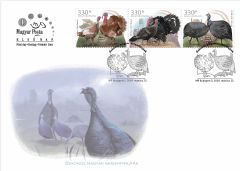Indigenious hungarian poultry breeds III. FDC
In 2022 Magyar Posta began releasing a new series called Indigenous Hungarian Poultry Breeds, which, based on the plans, is intended to present different poultry breeds annually over a number of years. In 2024, the Copper Turkey, the Bronze Turkey and the Hungarian Landrace Guinea Fowl feature on the stamps. The strip of three stamps designed by the graphic artist Ágnes Berta was produced by ANY Security Printing Company. The new issue is available from Filaposta, philately specialist services, certain post offices and www.posta.hu. It is characteristic of the hardiness and undemanding nature of the Copper Turkey that in Hungary flocks used to be driven on foot to market. The colour of the gobbler is dark copper-red on the fore part of the body with whitish wing and tail feathers. Its basic colour may be interspersed with pale and white barring. Its legs are pink and its skin white and the hen is slightly lighter. It was considered a disease resistant, hardy breed of turkey, laying plentiful spotted eggs. It is a good sitter and rears its chicks well as well as being a very good forager. It is currently maintained in two small gene bank flocks. The Standard Bronze Turkey is one of the oldest turkey breeds and is widespread throughout the world. It was introduced for cross-breeding and pure-breeding purposes in the second half of the 1800s. The Bronze Turkey quickly supplanted the smaller-bodied landrace breeds, and by the early 20th century it had become the most valuable and widespread turkey breed in Hungary. Its eggs are also speckled, or freckled. The shape of the body and the colour of the plumage of the Hungarian Bronze Turkey are the same as those of the Standard Bronze Turkey, but it is considerably lighter in weight, similar to the landrace varieties. The guinea fowl is a very valuable poultry species with excellent meat. It starts producing eggs at the end of April, laying 60 to 80 yellowish-red eggs weighing about 50 g each year. The eggs have thick shells and thus have a long shelf life. This very hardy, feisty poultry species with a wild nature is an excellent forager and insect controller, and for this reason it is advisable to keep it free range. In Hungary, mainly the bluish-grey and to a lesser extent the white variation is widespread, but grey (silver), brown (red) and mottled variations also occur. Source: nbgk.hu The stamps of the series show a male and a female of the indigenous poultry species: the Copper Turkey, the Bronze Turkey and the Hungarian Landrace Guinea Fowl. The accompanying cover features guinea fowl, while the imprint of the special postmark on the first day cover shows a stylised drawing of a turkey and a guinea fowl.
| Type | FDC |
| Short description | In 2022 Magyar Posta began releasing a new series called Indigenous Hungarian Poultry Breeds, which, based on the plans, is intended to present different poultry breeds annually over a number of years. |
| Printing Office | ANY Biztonsági Nyomda Nyrt. (stamp), Pátria Zrt. (FDC) |
| Issue year | 2024 |
| Issue time | 25 March 2024 |
| Theme | animals |
| Designer | Ágnes Berta |


